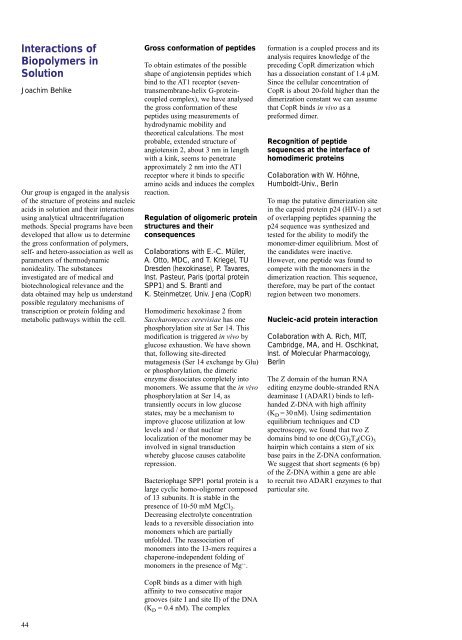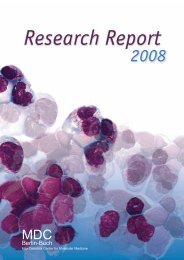Create successful ePaper yourself
Turn your PDF publications into a flip-book with our unique Google optimized e-Paper software.
Interactions of<br />
Biopolymers in<br />
Solution<br />
Joachim Behlke<br />
Our group is engaged in the analysis<br />
of the structure of proteins and nucleic<br />
acids in solution and their interactions<br />
using analytical ultracentrifugation<br />
methods. Special programs have been<br />
developed that allow us to determine<br />
the gross conformation of polymers,<br />
self- and hetero-association as well as<br />
parameters of thermodynamic<br />
nonideality. The substances<br />
investigated are of medical and<br />
biotechnological relevance and the<br />
data obtained may help us understand<br />
possible regulatory mechanisms of<br />
transcription or protein folding and<br />
metabolic pathways within the cell.<br />
44<br />
Gross conformation of peptides<br />
To obtain estimates of the possible<br />
shape of angiotensin peptides which<br />
bind to the AT1 receptor (seventransmembrane-helixG-proteincoupled<br />
complex), we have analysed<br />
the gross conformation of these<br />
peptides using measurements of<br />
hydrodynamic mobility and<br />
theoretical calculations. The most<br />
probable, extended structure of<br />
angiotensin 2, about 3 nm in length<br />
with a kink, seems to penetrate<br />
approximately 2 nm into the AT1<br />
receptor where it binds to specific<br />
amino acids and induces the complex<br />
reaction.<br />
Regulation of oligomeric protein<br />
structures and their<br />
consequences<br />
Collaborations with E.-C. Müller,<br />
A. Otto, <strong>MDC</strong>, and T. Kriegel, TU<br />
Dresden (hexokinase), P. Tavares,<br />
Inst. Pasteur, Paris (portal protein<br />
SPP1) and S. Brantl and<br />
K. Steinmetzer, Univ. Jena (CopR)<br />
Homodimeric hexokinase 2 from<br />
Saccharomyces cerevisiae has one<br />
phosphorylation site at Ser 14. This<br />
modification is triggered in vivo by<br />
glucose exhaustion. We have shown<br />
that, following site-directed<br />
mutagenesis (Ser 14 exchange by Glu)<br />
or phosphorylation, the dimeric<br />
enzyme dissociates completely into<br />
monomers. We assume that the in vivo<br />
phosphorylation at Ser 14, as<br />
transiently occurs in low glucose<br />
states, may be a mechanism to<br />
improve glucose utilization at low<br />
levels and / or that nuclear<br />
localization of the monomer may be<br />
involved in signal transduction<br />
whereby glucose causes catabolite<br />
repression.<br />
Bacteriophage SPP1 portal protein is a<br />
large cyclic homo-oligomer composed<br />
of 13 subunits. It is stable in the<br />
presence of 10-50 mM MgCl 2.<br />
Decreasing electrolyte concentration<br />
leads to a reversible dissociation into<br />
monomers which are partially<br />
unfolded. The reassociation of<br />
monomers into the 13-mers requires a<br />
chaperone-independent folding of<br />
monomers in the presence of Mg ++ .<br />
CopR binds as a dimer with high<br />
affinity to two consecutive major<br />
grooves (site I and site II) of the DNA<br />
(K D = 0.4 nM). The complex<br />
formation is a coupled process and its<br />
analysis requires knowledge of the<br />
preceding CopR dimerization which<br />
has a dissociation constant of 1.4 µM.<br />
Since the cellular concentration of<br />
CopR is about 20-fold higher than the<br />
dimerization constant we can assume<br />
that CopR binds in vivo as a<br />
preformed dimer.<br />
Recognition of peptide<br />
sequences at the interface of<br />
homodimeric proteins<br />
Collaboration with W. Höhne,<br />
Humboldt-Univ., Berlin<br />
To map the putative dimerization site<br />
in the capsid protein p24 (HIV-1) a set<br />
of overlapping peptides spanning the<br />
p24 sequence was synthesized and<br />
tested for the ability to modify the<br />
monomer-dimer equilibrium. Most of<br />
the candidates were inactive.<br />
However, one peptide was found to<br />
compete with the monomers in the<br />
dimerization reaction. This sequence,<br />
therefore, may be part of the contact<br />
region between two monomers.<br />
Nucleic-acid protein interaction<br />
Collaboration with A. Rich, MIT,<br />
Cambridge, MA, and H. Oschkinat,<br />
Inst. of Molecular Pharmacology,<br />
Berlin<br />
The Z domain of the human RNA<br />
editing enzyme double-stranded RNA<br />
deaminase I (ADAR1) binds to lefthanded<br />
Z-DNA with high affinity<br />
(K D = 30 nM). Using sedimentation<br />
equilibrium techniques and CD<br />
spectroscopy, we found that two Z<br />
domains bind to one d(CG) 3T 4(CG) 3<br />
hairpin which contains a stem of six<br />
base pairs in the Z-DNA conformation.<br />
We suggest that short segments (6 bp)<br />
of the Z-DNA within a gene are able<br />
to recruit two ADAR1 enzymes to that<br />
particular site.

















